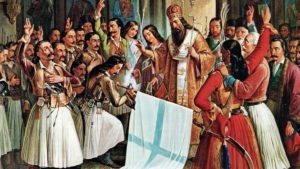The Greek Revolution of 1821 was a milestone in the history of modern Greece.
After 400 years of Ottoman rule, the creation of an independent Greek state began and the revolution inspired the Greeks in those turbulent times. This was also a major event in the modern history of Europe, as it brought changes that have an impact to this day. During the Greek Revolution of 1821, Skopelos took an active part in the struggle.
The social structure of Skopelos in the years of Ottoman rule
The traditions and customs of Skopelos were heavily influenced by the Ottomans. There was a strong division of social classes on the island. The ruling class consisted of the landowners and shipowners. They essentially ruled the island and undertook to pay the annual taxes to the Turks. The majority of the population were smallholders, farmers, laborers and sailors who manned the merchant fleet. The middle class was represented by few people, mainly merchants. Another small but prominent class was the clergy and the numerous monks on the island. Although no written testimonies have survived, there is evidence that confirms hatred and intense friction between social classes.
Skopelos in the Revolution
Skopelos took an active part in the revolution since the early beginning and several Skopelians were already initiated into the Filiki Eteria, a secret organization founded in 1814 in Odessa, whose purpose was to overthrow the Ottoman rule and establish a sovereign Greek state. It is a fact though that there was general insecurity among Skopelians due to the almost non-existent defense structures and fortifications. However, we can unequivocally say that the fleet of Skopelos supported decisively the Revolution in its early stages.
The naval battle of Lemnos
Ebu Lubut Pasha of Thessaloniki had planned the destruction of Skiathos and Skopelos and so the fear of an invasion on the island became more and more intense. However, the captains together with their henchmen were willing to defend the islands and the locals were ready to defend themselves with the help of the Hydraeans. Ηaving the information of an upcoming attack, Skopelians decided to attack first to halt the advance of the Ottomans. In March 1823 they met the fleet of Lubut Pasha near Lemnos and in the following naval battle, the Greeks prevailed, managing to temporarily push the Ottoman fleet away from the Northern Sporades.
Skopelos as a refugee asylum
One of the greatest services of Skopelos in the liberation struggle was the provision of asylum to refugees. After the initial failure of the revolutionary movements of Thessaly and Macedonia, refugees arrived in Skopelos and Skiathos to escape the rage of the Ottomans. After the destruction of Pelion by Dramalis, inhabitants and chiefs took refuge on the islands. The total number of refugees on both islands was 70,000. The refugees in turn enriched the local element and influenced the folk costume, architecture and culture in general.
Skopelos in the newly formed Greek state
Skopelos was officially integrated into the newly formed Greek state with the Treaty of Constantinople in 1832. It initially joined the prefecture of Evia along with the other islands of the Northern Sporades. In the 1910s, Skopelos was administratively integrated into the prefecture of Magnesia.
Source: https://elliniki-epanastasi.blogspot.com/p/blog-page.html?m=0



